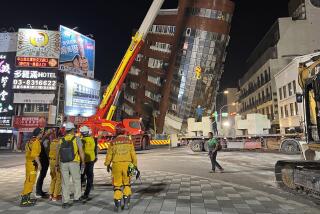How a 9.2 earthquake in Alaska in 1964 changed our understanding is explained in ‘The Great Quake’
Geological tumult is all around us in the American West, in our vertiginous topography and in our heads — fear of the Big One. But a little over half a century ago there came what, befitting its magnitude and locale — in the “Great Land” of the Aleut — may be called the Great One. Henry Fountain’s “The Great Quake” is dedicated to the five terrifyingly convulsive minutes around dinnertime on March 27, 1964, when the forces of geological upheaval, normally beneath our threshold of perception, violently obtruded into human time, reconfiguring not only the landscape of south central Alaska but our understanding of earthquakes and the risk posed today by the Big One and Really Big One.
For an idea of its power, consider the 1994 temblor that shook Northridge, killing 57, lasted a brisk 30 seconds at most. The Alaskan earthquake registered 9.2 on the Richter Scale (many times stronger than the biggest quake predicted along the San Andreas fault), making it the most forceful tremor ever recorded in North America. Globally, it’s second only to the 9.5 Chilean earthquake of 1960. Had it struck any sort of population density, the loss of life would have been calamitous. As it was, 131 people died (including 16 in Oregon and California — swept away by tsunamis that inundated the West Coast and points south). Fountain locates part of his story in the two communities that bore the brunt — Chenega and Valdez. They’re emblematic of a still-germinal Alaskan state (admitted to the Union in 1959): a native fishing village, population 75 — mostly related to one another — and old gold rush boomtown numbering 841 souls sustained since then as a transportation hub.
The ground itself was starting to break into strange, angular blocks, some rotating up and others down. It was as if swarms of organisms were inside the soil.
— Henry Fountain.
Avoiding portentousness, Fountain, a veteran New York Times science reporter, paints a deft portrait of life in these remote outposts. In Chenega it revolves around subsistence fishing and hunting and — legacy of an earlier overlord — the Russian Orthodox Church. And in Valdez, also economically marginal, life centers around the arrival of supply ships from Seattle, the unloading of which afford not only a spectacle for a town otherwise short on diversions but extra income for its underemployed. As the zero-hour approaches, myriad micro-acts seal fates, such as the decision to greet a new arrival at Valdez’s dock, which would collapse and pitch all on it into turbid ocean. Scenes of quotidian life trail off in ellipses: the sci-fi puppetry of “Fireball XL5” plays on televisions in Anchorage, farther from the epicenter but still pummeled.
Fountain isn’t a showy writer, but there’s a fever-dream quality to his account of those five minutes that “made the earth ring like a bell” that captures the hallucinogenic oddness of a world off-kilter, out-of-joint, suddenly uncooperative. Combinations of words with no earthly business being together occur. “[H]ouses seemed to dance in place,” he writes. Elsewhere, “Stairways wriggled and writhed.” Later, “the ground itself was starting to break into strange, angular blocks, some rotating up and others down. It was as if swarms of organisms were inside the soil, giving it life.” Or, “the rocks … began to bounce, like the ball in a game of jacks.”
Trees and buildings whipsaw, solid ground behaves like liquid, land cleaves apart, a comic symphony of water and sewage strikes up from exposed plumbing, the rakish progress of furniture across an Anchorage room later cues scientists to the course of the tremor. It’s a reminder of the puniness of our world when the earth shrugs.
Finally, there’s the spooky latency as the tide recedes — “to a distance of about a quarter of a mile and a depth of more than 120 feet” at Chenega — the preface to tsunamis that would be the killing blow for most victims. Afterward, the ocean runs red with dead fish flushed from the depths by turbulence, possibly stricken by a variant of “the bends” that afflict deep-sea divers surfacing prematurely.
It’s a reminder of the puniness of our world when the earth shrugs.
Don’t infer from this, though, that “The Great Quake” is simply a superior form of disaster porn. Fountain has written a braided narrative about the dialectic between scientific theory and observation that situates the Alaskan earthquake amid a decades-long quest to understand how the landscape around us evolved.
It’s an odyssey that begins with an oddball German polymath Alfred Wegener, who, gazing upon an atlas in 1911, notices the parallelism between the east coast of South America and west coast of Africa and posits that today’s continents originated in a unitary landmass he names Pangea.
Wegener stumbles, however, in supplying a plausible engine for continental drift. Later scientists suggest one: magma disgorged from the Earth mid-ocean that, impelled by the circular motion of convection, spreads the seabed, driving continents apart (at the stately pace of half an inch a year), but this remains an unsubstantiated theory — one author calling it “an essay in geopoetry.”
Enter George Plafker, product of Yonkers’ Hebrew National Orphan Home and Brooklyn College and implacable old-school rockhound, tasked by the U.S. Geological Survey with assessing the quake-wrought destruction on the ground. Traversing Alaska’s shattered coastline by barge and bush plane, he employs the field geologist’s tools — hammer, spirit level, compass, notepad and, to “read” the landscape, his eyes. He also applies the theoretical tool set furnished by Wegener and his heirs.
The analysis Plafker produces the following year in Science magazine describes the quake as the product of magma wedging the Pacific Ocean floor under North America, compacting the latter until it gave way. “[W]hen the fault ruptured,” Fountain writes, “the continental crust rebounded like a spring, up and out.” Plafker had laid out the dynamics of what is today called the “megathrust” earthquake, the type that decimated parts of Japan in 2011 and now imperils the Pacific Northwest. He’d also cemented acceptance of plate tectonics, the idea the Earth is fissured by grinding plates that, Fountain writes, supplies a master key for understanding not only earthquakes but “all the geological features and processes that humans have wondered about for centuries.”
Interleaving snapshots of a lost world, the primal power of nature and high science, “The Great Quake” is an outstanding work of nonfiction. It’s also a reminder that the original agent of creative destruction resides not in the corporate boardroom, ivory tower or artist’s salon but beneath our feet.
Phillips is a writer in Portland, Ore. He’s written for the Atlantic, NPR, the San Francisco Chronicle, the Financial Times, Times Higher Education and the South China Morning Post, among other publications.
“The Great Quake: How the Biggest Earthquake in North America Changed Our Understanding of the Planet”
Henry Fountain
Crown: 288 pp., $28
More to Read
Sign up for our Book Club newsletter
Get the latest news, events and more from the Los Angeles Times Book Club, and help us get L.A. reading and talking.
You may occasionally receive promotional content from the Los Angeles Times.






